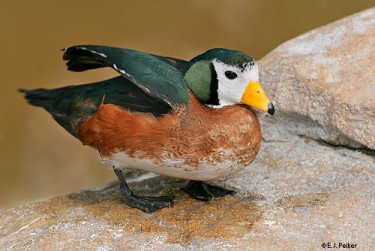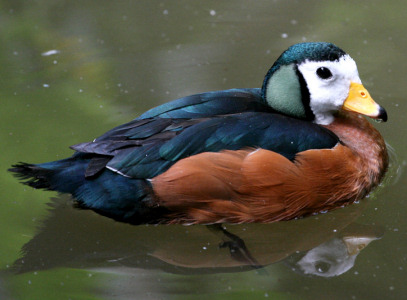
Nettapus auritus
SUBFAMILY
Anatinae
TAXONOMY
Anas aurita Boddaert, 1783, Madagascar. Monotypic.
OTHER COMMON NAMES
English: Dwarf goose, pygmy goose; French: Anserelle naine;
German: Afrikanische Zwergente; Spanish: Gansito Africano.
PHYSICAL CHARACTERISTICS
11.8–13.0 in (30–33 cm); 0.57–0.63 lb (260–285 g). Iridescent
green back with ruddy flanks and white underparts.
DISTRIBUTION
South of Sahara except southwestern Africa; islands of Pemba,
Zanzibar, Mafia, and Madagascar.
HABITAT
Shallow wetlands and slow flowing rivers with abundant floating
aquatic vegetation, preferrably water lilies.
BEHAVIOR
Territorial and sedentary, but moves in response to habitat changes.
FEEDING ECOLOGY AND DIET
Feeds on insects and quatic plants, especially seeds of water lillies,
while swimming. Also dives for small fish and aquatic insects.
REPRODUCTIVE BIOLOGY
Seasonally monogamous in captivity and in the wild. Nests in
tree cavities. Lays 6–12 eggs; incubation c. 23–24 days; sexually
mature probably at 1 year.
CONSERVATION STATUS
Not threatened. Locally common to abundant. Listed on Appendix
III of CITES for Ghana.
SIGNIFICANCE TO HUMANS
Hunted for food.
Photo Gallery of - African pygmy goose




 Animalia Life
Animalia Life